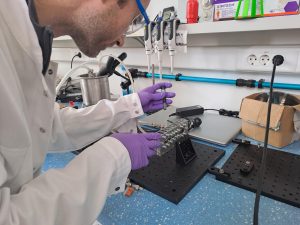The issue of wastewater treatment is an increasingly pressing problem in modern society, which is also being followed by scientific research in this field. Conventional treatment processes are inadequate for the increasing variety of pollutants entering all water bodies (surface and groundwater). Therefore, great efforts are being made to develop new technological approaches to solve this problem, and cavitation is proving to be one of the promising technologies.

Cavitation is a physical phenomenon in which small vapor bubbles form in a liquid due to a local drop in pressure. When they collapse, strong mechanical forces (shear forces, pressure shock waves, microjets) and chemical reactions occur, especially the formation of hydroxyl radicals. These radicals are extremely reactive and can effectively degrade organic micropollutants and inactivate bacteria and viruses in the water.
Until now, cavitation research has mainly been carried out on larger reactors with constrictions in the millimeter to centimeter range. In our study, we investigated the effects of microfluidic reactors with constrictions in the micrometer range. We found that reducing the size of the reactor significantly changes the properties of the cavitation flow – the formation of hydroxyl radicals increases, which accelerates the degradation of micropollutants.
The results show that a properly designed microreactor can increase the chemical effect by a factor of 30 compared to conventional systems. This opens up new possibilities for more efficient and economical water treatment.
The interdisciplinary research was carried out by scientists from the University of Ljubljana (Faculty of Mechanical Engineering, Faculty of Pharmacy) and Sabanci University in Istanbul (Turkey). The results were published in the renowned Chemical Engineering Journal (IF: 13.4).
“Our results show that microfluidic reactors enable more efficient control of cavitation. This technology can be used in industry, especially in water treatment,” emphasizes one of the lead authors of the study.
Future prospects: In the future, such microreactors could become key building blocks for compact and energy-efficient devices for water treatment, degradation of harmful chemicals or even material synthesis.
